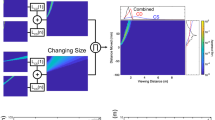Abstract
In this paper, we offer a stability analysis of “the cue interaction model” of depth perception (House (1984)). Depth estimation using stereopsis suffers from the “matching problem”, the problem of correctly matching the retinal image of a feature in one eye, to its retinal image in the other eye. The Cue Interaction Model overcomes this by using monocular cues to disambiguate between the “correct matches” and the “incorrect matches”. Its decision making is based on the concept of cooperation and competition in a neural network. A general class of cooperative and competitive models has been mathematically analysed by Amari and Arbib (1977), with special attention given to equilibrium states and stability. In this paper we adapt their methods to study the above model. In particular, we prove that if the parameters are correctly tuned, the model successfully achieves its goals by suppressing the cues which represent the “incorrect matches”.
Similar content being viewed by others
References
Amari, S., Arbib, M. A.: Competition and cooperation in neural nets. In Metzler, J. (ed.) Systems neuroscience, pp. 119–165. New York: Academic Press 1977
Arbib, M. A.: Levels of analysis of visuomotor coordination. Behav. Brain Sci., in press
Arbib, M. A., Boylls, C. C., Dev, P.: Neural models of spatial perception and control of movement. In: (Keidel, W. D., Handler, W., Spreng, M. (eds.)) Cybernetics and bionics, pp. 216–231. Munich: Oldenbourg 1984
Arbib, M. A., Overton, K. J., Lawton, D. T.: Perceptual systems for robotics. Interdisc. Sci. Rev. 9, 31–46 (1984)
Collett, T.: Stereopsis in toads. Nature, 267 349–351 (1977)
Dev, P.: Perception of depth surfaces in random-dot stereograms: a neural model. Int. J. Man-Machine Studies 7, 511–528 (1975)
Hirai, Y., Fukushima, K.: An inference upon the neural network finding binocular correspondence. Biol. Cybernetics 31, 209–217 (1978)
House, D. H.: Neural models of depth perception in frogs and toads. Ph.d Thesis, COINS Technical Report 84-16, Dept. of Computer and Information Science, University of Massachusetts at Amherst
Ingle, D.: Spatial visions in anurans. In: Fite, K. (ed.) The amphibian visual system: a multidisciplinary approach, pp. 119–140. New York: Academic Press 1986
Marr, D., Poggio, T.: Cooperative computation of stereo disparity. Science 194, 283–287 (1976)
Poggio, G., Poggio, T.: The analysis of stereopsis. Ann. Rev. Neurosci. 7, 379–412 (1984)
Author information
Authors and Affiliations
Additional information
Preparation of this paper was supported in part by NIH grant number NS-1 R01 NS24926 from NINCDS
Rights and permissions
About this article
Cite this article
Chipalkatti, R., Arbib, M.A. The cue interaction model of depth perception: a stability analysis. J. Math. Biology 26, 235–262 (1988). https://doi.org/10.1007/BF00277391
Received:
Revised:
Issue Date:
DOI: https://doi.org/10.1007/BF00277391




